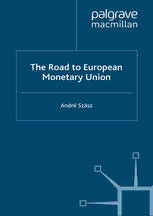
The Road to European Monetary Union PDF
Preview The Road to European Monetary Union
THE ROAD TO EUROPEAN MONETARY UNION This page intentionally left blank The Road to European Monetary Union Andre Szasz former Executil'e Director Dutch Central Bank First published in Great Britain 1999 by MACMILLAN PRESS LTD Houndmills, Basingstoke. Hampshire RG21 6XS and London Companies and representatives throughout the world A catalogue record for this book is available from the British Library. ISBN 978-1-349-27874-9 ISBN 978-0-230-59947-5 (eBook) DOT 10.1057/9780230599475 First published in the United States of America 1999 by ST. MARTIN'S PRESS, INC., Scholarly and Reference Division. 175 Fifth Avenue, New York, N.Y. 10010 ISBN 978-0-312-21873-7 Library of Congress Cataloging-in-Publication Data Snisz. Andre. The road to European monetary union I Andre Szasz. p. em. Includes bibliographical references and index. ISBN 978-0-312-21873-7 I. Monetary unions~European Union countries. 2. Monetary policy -European Union countries. 3. European Monetary System (Organization) 4. European Union countries~Economic integrution. I. Title. HG925.S93 1999 332.4'566'094~dc21 9~--40521 CIP ([) Andre Szasz 1999 All rights reserved. No reproduction, copy or transmission of this publication may he made without written permission. No paragraph of this publication may be reproduced. copied or transmitted save \\ ith written permission or in accordance with the provisions of the Copyright. Designs and Patents Act 1988, or under the terms of any licence permitting limited copying issued b) the Copyright Licensing Agency. 90 Tottenham Court Road, London WI P 9HE. Any person who does any unauthorised act in relation to this publication rna) be liable to criminal prosecution and civil claims for damages. The author has asserted his right to he identified as the author of this work in accordance with the Copyright. Designs and Patents Act 1988. This book is printed on paper suitable for recycling and made from fully managed and sustained forest sources. 10 9 8 7 6 5 4 OX 07 06 05 04 03 02 0 I 00 Contents Introduction XI 1 The Political Background to European Integration 1 1.1 The economic road 2 1.2 The impact of the Suez Crisis 2 1.3 Assessment 5 2 The Rome Treaty (1958) and the Barre Plans (1968-9) 7 2.1 Imbalances in the Treaty 7 2.2 CAP and a common currency 8 2.3 Economists and monetarists 9 2.4 The Barre plans 11 2.5 Assessment 12 3 Economic and Monetary Union: The Hague Summit of 1969 15 3.1 Tensions in the international monetary system 16 3.2 Tensions within the European Community 20 3.3 Brandt's new Ostpolitik 25 3.4 Assessment 28 4 The Werner Report (1970) 30 4.1 Monetary Union 30 4.2 Economic Union 31 4.3 Political Union 32 4.4 First stage 33 4.5 Assessment 34 5 The Snake (1972-8) 36 5.1 The snake in the tunnel 36 5.2 Moment of truth 37 5.3 Snake and mini-snake 39 5.4 Once again French problems 41 5.5 Assessment 43 v VI Contents 6 The European Monetary Cooperation Fund 46 6.1 Shift in purpose and timing 46 6.2 Controversies 47 6.3 Assessment 49 7 The Making of the European Monetary System (1978) 51 7.1 Transatlantic tensions 52 7.2 The exchange rate mechanism 52 7.3 The European Monetary Fund 54 7.4 Schmidt's problem and solution 55 7.5 Confronting the partners 56 7.6 Back to the snake 58 7.7 Schmidt and Giscard 60 7.8 Assessment 62 8 The Working of the European Monetary System in the Period 1979-87 66 8.1 1979-83: Crisis 67 8.2 Basle-Nyborg 69 8.3 Assessment 74 9 Promoting the ECU 76 9.1 The Fund 77 9.2 Acceptance limits 78 9.3 Negotiations 80 9.4 Assessment 82 10 The Single European Act (1985-6) 85 10.1 Capital liberalisation 86 10.2 A 'monetary dimension' in the Treaty 89 I 0.3 The Luxemburg European Council 92 10.4 Assessment 95 11 French-German Tussle: Monetary Union Revived (1987-8) 98 11.1 French dependence on German policies 98 11.2 Changes in technical arrangements 99 11.3 French-German Financial and Economic Council 100 Contents v11 11.4 French proposal for a European Central Bank 101 11.5 German reactions 103 11.6 The link with security and defence 106 11.7 Assessment I 07 12 The Delors Report 110 12.1 Composition and mandate of the Dclors Committee 110 12.2 The requirement of unanimity 112 12.3 The report's contents 115 12.4 Assessment 118 13 British Opposition 120 13.1 British reaction to the report 120 13.2 Thatcher's options 122 13.3 Assessment 127 14 The Madrid Summit (June 1989) and its Follow-up 130 14.1 Timing and substance 131 14.2 Long or short transitional stage 134 14.3 Assessment 135 15 German Unification (1989-90) 137 15.1 Exodus 137 15.2 German Monetary Union 139 15.3 Two sides of the same coin 141 15.4 Assessment 144 16 Monetary Union 147 16.1 Central Bank independence 147 16.2 French rearguard action 150 16.3 Assessment 152 17 Economic Union 154 17.1 Why budget constraints 155 17.2 Economic Government 156 17.3 Excessive deficits 158 17.4 Convergence criteria and the third stage 160 17.5 Assessment 162 VIII Contents 18 Ratification (1992-3) 165 18.1 Danish disaster 165 18.2 French miscalculation 167 18.3 British agony 168 18.4 German last comer 168 18.5 Assessment 170 19 Black September (1992) 172 19.1 The lira's devaluation 172 19.2 First steps to Black Wednesday 174 19.3 Crisis 177 19.4 Aftermath 180 19.5 The lessons of September 1992 182 19.6 Assessment 182 20 The Collapse of the Old EMS (1993) 185 20.1 Lost opportunities 185 20.2 Prelude to derailment 188 20.3 The July crisis 190 20.4 The crises in retrospect 192 20.5 Assessment 194 21 The Guilder: A Case Study of a Hard Currency Policy 196 21.1 Trailing the German mark 196 21.2 The last devaluations (1979 and 1983) 198 21.3 Interest rate controversies 201 21.4 The guilder and the crisis of 1992 204 21.5 German-Dutch bilateral agreement 205 21.6 Assessment 210 22 Why the Euro? 213 22.1 German motives 213 22.2 French motives 216 22.3 The decision-making process 219 22.4 Contradictions 222 22.5 Dilemmas 225 22.6 Conclusion 228 Contents IX Notes 230 Bibliography 248 Index 254
